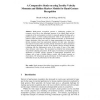Free Online Productivity Tools
i2Speak
i2Symbol
i2OCR
iTex2Img
iWeb2Print
iWeb2Shot
i2Type
iPdf2Split
iPdf2Merge
i2Bopomofo
i2Arabic
i2Style
i2Image
i2PDF
iLatex2Rtf
Sci2ools
145
Voted
AMDO
2008
Springer
2008
Springer
A Comparative Study on Using Zernike Velocity Moments and Hidden Markov Models for Hand Gesture Recognition
Hand-gesture recognition presents a challenging problem for computer vision due to the articulated structure of the human hand and the complexity of the environments in which it is typically applied. Solving such a problem requires a robust tracking mechanism which in turn depends on an effective feature descriptor and classifier. Moment invariants, as discriminative feature descriptors, have been used for shape representation for many years. Zernike moments have been particularly attractive for their scale, translation and rotation invariance. More recently, Zernike moments have been extended to a spatio-temporal descriptor, known as the Zernike velocity moment, through combining with the displacement vector of the centre of mass of the target object between video frames. This descriptor has hitherto been demonstrated successfully in human gait analysis. In this paper, we introduce and evaluate the application of Zernike velocity moments in hand-gesture recognition, and compare with a...
Related Content
| Added | 12 Oct 2010 |
| Updated | 12 Oct 2010 |
| Type | Conference |
| Year | 2008 |
| Where | AMDO |
| Authors | Moaath Al-Rajab, David Hogg, Kia Ng |
Comments (0)

